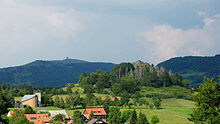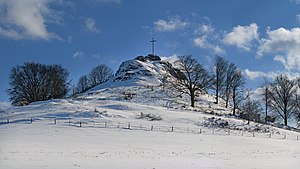Sticks
| Sticks | ||
|---|---|---|
|
The stake in winter from the northwest |
||
| height | 705 m above sea level NN | |
| location | Hessen , Germany | |
| Mountains | Rhön (Kuppenrhön) | |
| Coordinates | 50 ° 28 '13 " N , 9 ° 53' 33" E | |
|
|
||
| Normal way | Footpath to the top | |
The Wachtküppel - also called Lausbub or Spitzbub der Rhön - is 705 m above sea level. NN high mountain in the Rhön in Hesse ( Germany ). Below the mountain is the Wendelinus Chapel, also known as the Chapel on the Wachtküppel . Not far from the mountain there is an abandoned sandstone quarry that was used as a barbecue area for several years.

Geographical location
The Wachtküppel rises within the district of Fulda on the edge of the Fulda Valley in the Hessian Rhön Nature Park or in the Rhön Biosphere Reserve . In the Kuppenrhön it is located in the Maiersbach district of the Gersfeld community. Poppenhausen (Wasserkuppe) is 2.5 km northwest and Gersfeld 3 km southeast.
The boundary to the municipality of Poppenhausen runs along the field path northeast of the summit, so that the quarry at Wachtküppel and the parking lot are not far from the Wendelinus chapel in the area of the Gackenhof district of the municipality of Poppenhausen.
Mountain description
The hilltop is the remainder of a volcanic vent . The rocky peak towers over the surrounding hill by only a few meters. It can be climbed on a footpath and, thanks to its exposed location, offers an excellent view on all sides.
The rock of the Wachtküppel creates a magnetic anomaly : it contains so much magnetite that magnetic compasses on and on the mountain do not provide a reliable north indication.
At the foot of the Wachtküpp there is a geological nature trail that starts in the nearby parking lot.
history
The Wachtküppel was once an advanced and fortified sentry that was connected to Ebersburg Castle on the Ebersberg . It was built around 1200. Beacons warned of impending dangers. The complex consisted of a watchtower, a warehouse and an enclosure wall made of quarry stone and a rampart made of earth. When the Ebersburg was destroyed by the Fulda troops in 1270 , the fortification on the watch peg was also razed. After the reconstruction of the Ebersburg at the end of the 14th century, the guard post was also used again for some time. In old archives, the prominent hill also appears as the “Spiel- or Pfaffenberg”.
By 1870 there was already a cross on the summit, later a flagpole on which the black-white-red flag was hoisted on special occasions during the imperial era . In 1951, "Bergkaplan" Hermann Mott erected a new cross to commemorate the dead of both world wars. It was labeled:
To the fallen
dear ones rests in a strange land.
Here is the ribbon for you and us.
That connects us, near and far.
The sign of Christ our Lord.
Transfigured with him we rise again.
See the eternal home united with Him.
May 3, 1951
This inscription can also be found on the cross, which was rebuilt on April 25, 1989 after the previous one was destroyed by a lightning strike.
Quarry and barbecue area
About 250 m northeast of the summit is an abandoned quarry ( 50 ° 28 ′ 16.9 ″ N , 9 ° 53 ′ 19.9 ″ E ). The quarry is hidden in the forest below the level of the nearby dirt road. From the quarry area, which consists of several sub-areas, stone from the Solling formation of the upper Middle Buntsandstein was quarried, which was used throughout the Rhön for the extraction of natural stones. The location of the quarry suggests that it was important for the city of Fulda.
The area is owned by the State of Hesse and is managed by the Hofbieber Forestry Office.
In the quarry, only material from the Solling Formation, which is about four meters thick, was quarried. The bottom is in the area of the carnelian- dolomite horizon of the formation. The straight walls of the quarry with walls almost at right angles to each other are striking. They are not the conscious result of human work, but result from the natural vertical fissures . This natural formation made the extraction of stone relatively easy. The natural color was a classic light red for the middle red sandstone with a tinge of violet, which partly merged into whitish. Mining was carried out from several sandstone banks up to two meters thick , between which there were no major intermediate layers .
The quarry was developed as a barbecue and festival area by the administration of the Hessische Rhön Nature Park from the 1970s and was used intensively as such in the following years. After the safety devices were repeatedly destroyed and the surroundings were disturbed, the facilities, which consisted of a barbecue hut and a larger refuge, were demolished in 2007 and further use for these purposes was prohibited. In the meantime, the square is overgrown with bushes and young trees as part of the succession .
Wendelinus Chapel
The first chapel on the Wachtküppel was the so-called house chapel , in which the priest Hermann Mott celebrated the first Holy Mass in August 1944. Pope Pius XII had given permission to build the chapel. A year later it was too small. Thereupon a barracks for the Reichsarbeitsdienst dismantled in Abtsroda and rebuilt on the Wachtküppel as a barrack chapel . This was inaugurated on October 20, 1946 by the Fulda vicar general and dedicated to St. Wendelinus . A relic of St. Wendelinus, which was obtained from St. Wendel in Saarland, has been kept here since October 20, 1947 . At the beginning of the 1960s this barrack chapel became too small again. As a result, today's Wendelinus Chapel was built from 1962 and inaugurated in 1964. The chapel has a bell tower with three bells. In 1971 a memorial stone for the chaplain Hermann Mott (1906–1968), made by the sculptor Johannes Kirsch , was erected at the chapel .
See also
See also
literature
- Michael Mott : A bald "rascal" keeps watch / The 706 meter high guard is to receive a new summit cross. In: Fuldaer Zeitung , March 29, 1989, p. 16.
- Michael Mott: A medieval lucky charm - the stake released the historical horseshoe. In: Fuldaer Zeitung, January 3, 1992, p. 12 (series: DENK-mal!).
- Marcel Stumpf: Chapel of St. Wendelinus Wachtküppel , brochure.
Web links
Individual evidence
- ↑ a b c Heiner Flick, Adalbert Schraft: The Hessian Rhön - Geotopes in the Land of Open Afar , Hessian State Office for Environment and Geology, 2013, ISBN 3-89026-373-9 , pp. 198-200
- ↑ a b Abandoned barbecue area in the quarry at Wachtküppel ( memento from December 1, 2017 in the Internet Archive ) from November 25, 2007 in the news archive of the Fulda district (accessed on February 26, 2016).





